SAILING. VOR2012, Leg 5 Day 20 – PUMA held firm in the face of a relentless attack from Telefónica to clinch an epic Leg 5 victory on Friday, crossing the finish line in Itajaí, Brazil with a winning margin of just 12 minutes after the Spanish team had threatened to complete one of the great sporting comebacks.
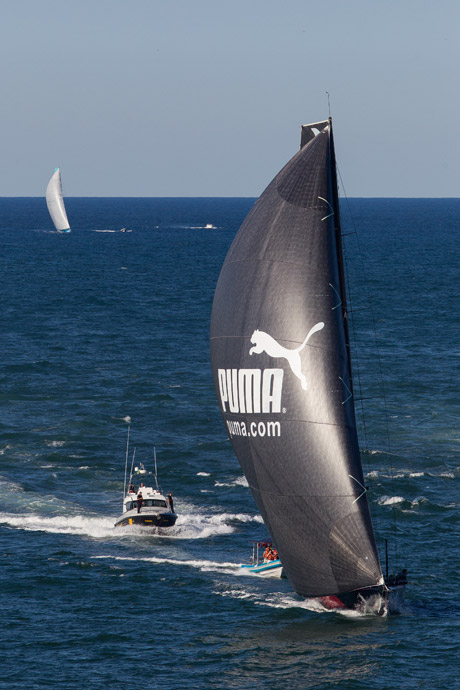
PUMA Ocean Racing powered by BERG, skippered by Ken Read from the USA are followed by a spectator fleet, as they take first place ahead of Team Telefonica, skippered by Iker Martinez from Spain, on leg 5 from Auckland, New Zealand to Itajai, Brazil, in the Volvo Ocean Race 2011-12. (Credit: IAN ROMAN/Volvo Ocean Race)
After more then 7,500 nautical miles of racing from Auckland, starting with a first-night battering as bad as any in the race’s history and on through brutal conditions in the Southern Ocean and around Cape Horn, PUMA’s Mar Mostro finished in brilliant sunshine at 19:09:51 UTC.
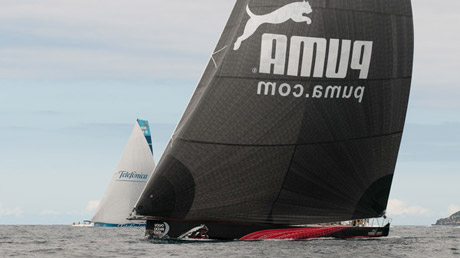
PUMA Ocean Racing powered by BERG, skippered by Ken Read from the USA and Team Telefonica, skippered by Iker Martinez from Spain, battle it out in the final miles of leg 5 from Auckland, New Zealand to Itajai, Brazil, during the Volvo Ocean Race 2011-12. (Credit: PAUL TODD/Volvo Ocean Race)
Telefónica, who had been a constant threat to them, followed her in at 19:22:29 UTC for a second place that strengthens their position as overall leaders with five of nine offshore legs now complete.
Both boats were roared home by dozens of spectator boats and thousands of fans lining every possible viewing position on the way in.
It was an extraordinary finish to the battle for first place in a leg that saw five of the six boats forced to stop for repairs.
Telefónica were 400 nm behind the leaders when they resumed racing following a pit stop to work on structural damage to their boat. They quickly began to reduce that gap and when Groupama sailing team were forced out following a dismasting they were suddenly in a two-way battle for first.
PUMA Ocean Racing powered by BERG score 30 points for their win, taking their total to 113 points. It means they are just 34 points behind overall leaders Team Telefónica, despite having been forced to retire from Leg 1 because of a broken mast.
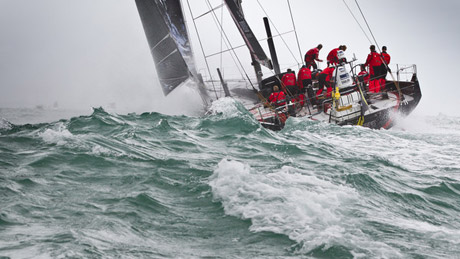
PUMA Ocean Racing powered by BERG, skippered by Ken Read from the USA during the start of leg 5 of the Volvo Ocean Race 2011-12, from Auckland, New Zealand to Itajai, Brazil. (Credit: IAN ROMAN/Volvo Ocean Race)
Groupama will reduce the Telefónica lead to 20 points if they complete the leg in third place under jury rig, as planned.
CAMPER with Emirates Team New Zealand, currently carrying out repairs in Puerto Montt in Chile, can get back to within 28 points if they complete the leg in fourth.
As it became clear that PUMA were doing enough to hold off Telefónica, the team's Media Crew Member Amory Ross handed out chocolate treats to the crew, before skipper Ken Read took back the helm to take his team over the finish line.
"We've never seen such an amazing welcome," said an overwhelmed looking Read, who took time to sympathise with his five rivals and their problems over the course of the leg.
"I've never done such a tough offshore leg in my life. It's been pretty intense. Our hearts go out to the crews who have suffered damage. We know what that's like and it's even worse when it's in a place like the Southern Ocean."
Telefónica had been written off after suspending racing for 17 hours for structural repairs inside the Cabo de Hornos National Park on March 31. The team resumed racing at 2133 that same day, more than 400 nm behind the leaders.
Nevertheless, a powerful South Atlantic front that rose from the south propelled Telefónica to within striking range of PUMA within days. Anxiety levels were rising on board PUMA, even after Groupama’s dismasting on April 4, but Read’s men were able to steel their nerves in a long match-race to the finish line for their first leg victory in this edition.
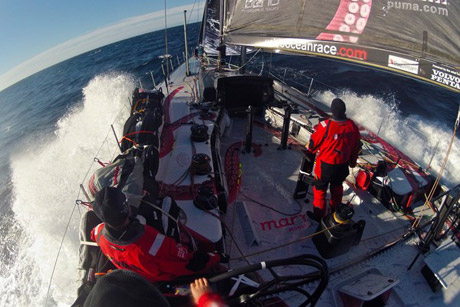
Flat water and 20 knots of wind, onboard PUMA Ocean Racing powered by BERG during leg 5 of the Volvo Ocean Race 2011-12, from Auckland, New Zealand, to Itajai, Brazil. (Credit: Amory Ross/PUMA Ocean Racing/Volvo Ocean Race)
PUMA have had a steady rise since the devastating blow of their broken mast on Leg 1. In the past four scoring events PUMA have finished second three times and now first, with real momentum with the American-based team as they head towards Leg 6 to Miami in the United States.
Abu Dhabi Ocean Racing will ship their boat to Itajaí for Leg 6, while Sanya will rejoin the race in Miami after losing a rudder while leading earlier on Leg 5.
Volvo Ocean Race
www.volvooceanrace.com
April 6, 2012 - 2030 UTC
GROUPAMA SUSPEND RACING WITH BROKEN MAST
Groupama sailing team suspended racing from the fifth leg of the Volvo Ocean Race after the mast broke just above the first spreader. The crew are all safe with the team 60 nautical miles south of Punta del Este.
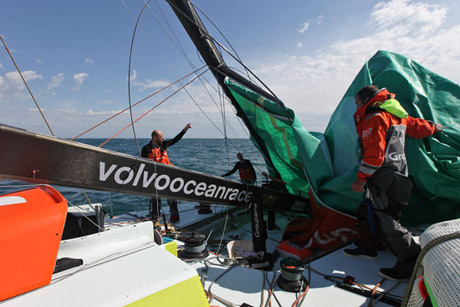
Groupama Sailing Team, skippered by Franck Cammas from France, suspend racing from leg 5 of the Volvo Ocean Race 2011-12, from Auckland, New Zealand to Itajai, Brazil, after the mast broke just above the first spreader around 60 nautical miles south of Punta del Este. (Credit: Yann Riou/Groupama Sailing Team/Volvo Ocean Race)
"We just lost the rig now, all the crew is safe. We are working to stabilize the rig on the boat. Not easy," skipper Franck Cammas told Race HQ.
"We suspend the race now and have a look at what doing. We are 59 miles to Punta del Este."
Groupama 4 was holding a narrow lead over PUMA's Mar Mostro in the leg from Auckland to Itajaí in southern Brazil when the incident was reported to Race control around 1540 UTC.
Volvo Ocean Race will release more information as it becomes available.
Volvo Ocean Race
www.volvooceanrace.com
April 4, 2012 - 1645 UTC
CAMPER HEAD FOR THE HORN
VOR2012, Leg 5 Day 22 – CAMPER were back in action and heading to Cape Horn on Sunday after resuming racing -- while Groupama closed in on third place in Leg 5.
Six days after they suspended racing and headed to Puerto Montt in Chile, Chris Nicholson’s men on CAMPER with Emirates Team New Zealand were back in racing mode for the more than 2,500 nautical miles they still have to sail to the finish line in Itajaí.
CAMPER officially resumed racing at 0441 UTC after motoring through Chile’s waterways for more than 26 hours to get back to the position at which they suspended.
To complete the leg they must take on the feared Cape Horn, the most southerly tip of South America, one of the most dangerous places to sail in the world.
“It already feels colder here than we remember, and unfortunately for us it is only going to get colder until we eventually round Cape Horn and head north again to more tropical waters,” said CAMPER Media Crew Member Hamish Hooper.
“From what I learn from the guys on board this is now very late in the year to be rounding Cape Horn so hopefully we get lucky and into a nice weather window to take us down, around and up safely over the next few days.
“Right now the wind is very light, the swells are such that the boat bangs down off each wave.
“I am slowly getting used to the banging bow again. It wasn’t an enjoyable sound when it was weakened for the 10 days before we stopped in for repairs.
“But with each bang the boat sure feels stronger than it did when vibrations would reverberate right through its bones last week.”
CAMPER were forced to divert to Chile after discovering structural problems.
They are guaranteed at least 15 points for completing the leg following the retirement of Team Sanya and Abu Dhabi.
Meanwhile, Groupama were within 325 nautical miles of the finish, having resumed racing with a temporary rig on Saturday.
Franck Cammas’ team, down to seven men for the final stretch, were hitting speeds of up to 19 knots despite sailing with a rig made from the broken pieces of their mast.
“We are always keeping in mind not to ask too much to our rig,” said MCM Yann Riou.
Groupama are on course to pick up 20 points for finishing Leg 5 in third place, a result that will take them back up to second place, 20 points behind Team Telefónica.
Telefónica finished the leg as runners-up to PUMA Ocean Racing powered by BERG on Friday.
Volvo Ocean Race
www.volvooceanrace.com
April 8, 2012 - 1430 UTC
AMBITIOUS RIVALS STEP UP POINTS PURSUIT
VOR2012, Leg 5 Day 23 – Groupama sailing team have less than 150 nautical miles standing between them and a podium position that will keep them in the running for overall race victory, while Chris Nicholson’s equally ambitious CAMPER are feeling a chill as they make their trek south towards Cape Horn.
Groupama skipper Franck Cammas and his men on board the damaged Groupama 4 have been averaging 9.05 knots over the past day, covering 217.2 nm in 24 hours.
The French team have set a steady pace since cautiously resuming racing on April 7 with a jury rig and three reefs in their main after breaking their mast and suspending racing on April 4.
Helmsman/trimmer Charles Caudrelier said that it was frustrating to go against the team’s grain and race at a reduced speed, but he admitted it was better than the alternative.
“It’s a bit frustrating,” he said. “You want to arrive quickly for your holidays, but it’s way less frustrating than acting like a fool, breaking your mast and getting one more week of going back to the land to repair, before leaving again.
“We have accepted our fate now. We are lucky enough to be able to finish in third place and with a jury rig that’s a huge opportunity.
“That’s our goal: finish on the podium and stay in the race. As the legs go by, we feel more comfortable and we are improving. We think we can still do things, we think we can still win legs and, why not, the overall ranking.”
Groupama will close to within 20 points of overall leaders Team Telefónica when they complete the Leg 5 course in third place.
CAMPER with Emirates Team New Zealand were donning their thermals on Monday as they headed due south down the Chilean coast towards Cape Horn.
Nicholson said that without a competitor even in the same ocean it was a lonely race but the team were remaining motivated by the promise of 15 points that will move them back up third place and within 28 points of Telefónica.
“The incentive for us here is to still get a fourth place and get valuable points,’’ he said. “It’s not as bad or as hard as people think. Certainly the next eight days we’re looking at to get to Itajaí, they’re a lot easier than the eight or nine days it took us to get to Puerto Montt when we broke the boat.”
The threat of a giant low pressure system that is due to rise from the Southern Ocean later this week is also motivating the team.
“We’ll still have 30-40 knots, so it’s still very windy in anyone’s books,’’ Nicholson said. “It’s all running conditions, and then once we’ve passed Cape Horn there’ll be a lot of tight reaching. But all in all it’s all looking pretty good. We need to get around the cape reasonably fast, there is a lot of breeze coming, so hopefully we can stay in front of all that.”
CAMPER have more than 2,400 nautical miles remaining and are averaging 10.15 knots with a 24-hour distance of 243.68 nm.
The team resumed racing at 0441 UTC on Sunday after suspending racing to fix structural damage on April 3.
Abu Dhabi Ocean Racing were due to leave Puerto Pontt by ship on Monday after reluctantly accepting they could not repair their boat in time to complete the leg.
They hope to continue their pursuit of points in the Itajaí In-Port Race on April 21.
Volvo Ocean Race
www.volvooceanrace.com
April 9, 2012 - 1430 UTC
HEROIC RECOVERY SEES GROUPAMA HOME IN THIRD
VOR2012, Leg 5 Day 24 – Groupama completed a heroic recovery to claim third place in Leg 5 of the Volvo Ocean Race on Tuesday, limping across the finish line in Itajaí with a jury-rigged mast for 20 points that revive their hopes of overall victory.
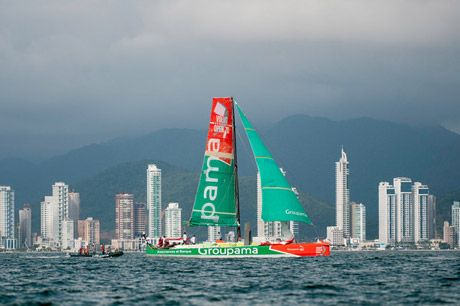
Groupama Sailing Team, skippered by Franck Cammas from France, sailing under jury rig, as they approach the finish line in Itajai, during leg 5 of the Volvo Ocean Race 2011-12, from Auckland, New Zealand to Itajai, Brazil. (Credit: PAUL TODD/Volvo Ocean Race)
Just six days ago Franck Cammas’ crew were questioning what they had done to deserve their ill fortune after a broken mast ended dreams of a second consecutive leg win.
Cammas’ crew opted to put into Punta del Este in Uruguay where they strung together an ingenious makeshift rig which they nursed all the way to the finish.
Victory in the 6,700 nautical mile leg from Auckland to Itajaí would have seen the French team move within touching distance of overall leaders Team Telefónica.
As it is, third place -- behind winners PUMA Ocean Racing powered by BERG and second-placed Telefónica -- was enough to take them back up to second overall, within 20 points of the lead.
"At the time all our focus was on winning the race and when the mast broke we had to change our strategy pretty quick," Cammas said.
"The guys all did a fantastic job and I am very happy with our podium place. The mood among the guys is very good and we're still right in this race."
After leading the fleet through much of the Southern Ocean, Groupama were also the first round Cape Horn, the southern tip of South America.
They appeared to be winning their duel with PUMA through the South Atlantic when disaster struck.
They suspended racing at 1542 UTC on April 4 after their mast snapped in two, just level with the first set of spreaders, around 10 metres above the deck.
The sailors were able to recover most of the rig and made for the Uruguayan city of Punta del Este, around 60 miles from where the incident happened.
A round-the-clock repair effort saw a makeshift rig fashioned from the bigger of the two broken parts of the mast in just three days.
The team resumed racing at 0500 UTC on April 7 with seven crew on board including bowman Brad Marsh, who had five staples put into his wrist after accidentally plunging a knife into it while cutting away the mainsail from the broken mast.
"I'm responsible for the rigging and I didn't want to leave the guys to have to deal with that on their own," New Zealander Marsh said. "Now I'm really pleased to have completed the leg."
Groupama now have 127 points overall after crossing the finish line at 1358 UTC on Tuesday, completing the leg in 23 days, 12 hours, 58 minutes and 45 seconds.
CAMPER with Emirates Team New Zealand are on course to finish Leg 5 in fourth place and should climb back up to third with 119 points.
Abu Dhabi Ocean Racing, who like CAMPER were forced to stop at Puerto Montt in Chile after suffering structural damage, were unable to complete the leg. They left the port by ship on Tuesday and should arrive in Itajaí in time for the in-port race on April 21.
Team Sanya were also forced to retire from the leg and will rejoin the leg in Miami.
Volvo Ocean Race
www.volvooceanrace.com
April 10, 2012 - 1500 UTC
CAMPER TICK OFF CAPE HORN ROUNDING AND HEAD FOR BRAZIL
VOR2012, Leg 5 Day 25 – CAMPER with Emirates Team New Zealand rounded Cape Horn under the cover of darkness on Wednesday, marking a major milestone on their mission to complete Leg 5 to Itajaí, Brazil.
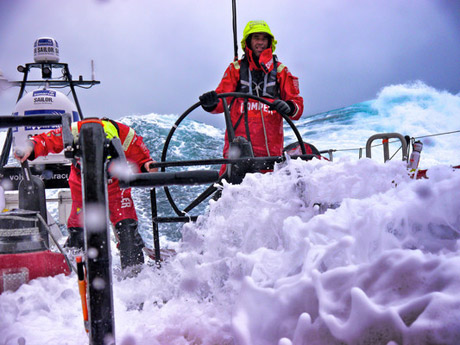
Stuart Bannatyne and Adam Minoprio on watch as CAMPER with Emirates Team New Zealand pass into the 'furious fifties' on their way South to Cape Horn during leg 5 of the Volvo Ocean Race 2011-12, from Auckland, New Zealand to Itajai, Brazil. (Credit: Hamish Hooper/CAMPER ETNZ/Volvo Ocean Race)
The CAMPER crew passed the cape at 0025 UTC, catching brief but poignant glimpses of the headland when the lighthouse flashed, Navigator Will Oxley said.
“We didn’t do much (to mark the occasion) because by that stage we were in to 25 to 30 knots, beam reaching, so it was fire-hose weather on deck,’’ he said. “We acknowledged we had passed it, spent a bit of time staring at a flashing light and got into focusing on the next landmark.”
Despite being unable to properly sight the cape, Media Crew Member Hamish Hooper said the team were nevertheless pleased to have passed one of the classic ocean racing waypoints.
“Unfortunately when we rounded it was dark, no moon to even lighten it for a slight sighting,’’ Hooper said.
“For some reason this doesn’t seem to bother me, more often than not it would with a landmark like this, but I guess it illustrates the relief and jubilation of finally making our way north out of the relentless Southern Ocean.”
Hooper along with helmsman/bowman Daryl Wislang and helmsman/trimmer Adam Minoprio were rounding Cape Horn for the first time, while helmsman/trimmer Tony Rae and co-skipper Stu Bannatyne, have passed the Cape four and seven times respectively.
Skipper Chris Nicholson said it was late in the year to be taking on Cape Horn, but having been delayed by structural damage which forced the team to suspend racing on April 3 and resume on April 8, there was little choice.
“Ideally you want to be doing this in February, but there have been a few little delays,’’ he said. “It’s been quite a marathon really for all of us in the team to get here at this stage. We would have done an extra 2,000 miles than everyone else, and taken 10 days longer.”
Since the rounding CAMPER have been battered by gusts in excess of 60 knots and are racing with a reefed mainsail and storm jib, Oxley said.
They have their sights firmly set on the Falkland Islands with an estimated time of arrival in Itajaí around the end of the week.
“Our plan is to pass to the east of the Falklands, try and use this wind to project us fairly quickly to the north east,’’ Oxley said. “We have our arrival some time around the 15th, but there are plenty of landmines between now and then.”
At 1300 UTC CAMPER had 1752 nautical miles remaining on the racetrack to Itajaí. If they successfully complete Leg 5 they will receive 15 points, and return to third place on the overall leaderboard.
Volvo Ocean Race
www.volvooceanrace.com
April 11, 2012 - 1515 UTC
SKIPPERS COMMENT ON LEG 5 ATTRITION
Leg 5 from Auckland to Itajaí saw the highest attrition rate on the fleet to date, with just one boat making it all the way without stopping, one of the three finishers so far coming home under a jury rig, two others loaded on cargo ships and one still to finish.
The problems sparked comment and speculation in the world’s sailing media and across online forums over the designs and building of the boats, the route of the race, the style of racing, the ice exclusion zone and even the time of year the leg was sailed.
The Volvo Ocean Race talked to people who should know best -- the six skippers themselves -- to get their opinion on the problems.
CAMPER with Emirates Team New Zealand skipper Chris Nicholson described the latest generation boats as difficult to build and to sail but said that challenge was integral to the allure of the Volvo Ocean Race for the fans and part of the job for the professional sailors who race them.
“You just can’t produce these faster boats -- this exciting offshore action and also the in-port racing -- you just can’t deliver the speed and thrills without some breakages,” he said.
“I imagine there are quite different opinions out there but everyone sailing on these boats know exactly what they are capable of,” Nicholson added. “We could be racing around in steel hulled boats, doing a maximum of 12 knots, never breaking anything and effectively turning everyone away from watching the race.
“I like the combination that we have. It’s very challenging and that’s one of the reasons it draws the best sailors in the world. These are pretty cool boats but they are difficult -- and that is how it should be at this level of the sport.”
Team Telefónica skipper Iker Martínez believes that damage to boats in a round the world race is virtually inevitable and a factor the skippers and crews need to take into consideration when setting their strategies.
“The boats get damaged because they are very fast,” Martínez said. “They can easily reach 40 knots and to not have any damage at that speed the boat would have to be very strong and thus not ideal to win an around a world race.
“The best way to win this race is to have a very fast boat and stop it when it needs to be stopped,” he added. “That is the type of boat that we have, we compete with it, and we have to take all of that into account and that’s that.”
Team Sanya’s Mike Sanderson, the only skipper in the current edition to have won the Volvo Ocean Race, says boat failures are absolutely to be expected, given the astonishing performance of the latest batch of Volvo Open 70s.
“When they’re going fast they crash hard,” said Sanderson, who skippers the only older generation boat in the race. “Just take a second and look at what these guys put these boats through. Sometimes they’re not even trying, you know. Sometimes they’re trying to slow the boats down and they can’t. They’re incredible.”
Sanderson said boat damage had always been a part of the Volvo Ocean Race and cited his experience in the 2005-06 race which he won on ABN AMRO ONE. “It was the first time the (new) boats had been used in the race and we had loads of problems, especially with the keel,” Sanderson said.
“We were using new things that hadn’t been tried before and there were failures. But there were also spectacular performances and distances covered like no one had ever seen before, especially in monohull boats.”
Abu Dhabi Ocean Racing skipper Ian Walker also pointed to a previous edition as evidence that fleet-wide boat damage was nothing new. “In the last race we only had one tough leg -- on the way to China -- and don’t forget three boats ended up getting smashed up on that leg and the others stopped,” he said.
However, Walker said that the fact that this time only Leg 5 winner PUMA Ocean Racing powered by BERG had made it to Brazil without stopping was a strong indicator that something was wrong.
“We -- not just us, all the teams -- just don’t seem to be able to get through the tough conditions in this race,” he said. “Before the start of Leg 5 it hadn’t been too bad. We hadn’t had too many breakages up until then.
“When you look at this leg however, you have to say we can’t go on like this.”
Walker did not put any blame on the design parameters or the quality of the boats’ construction for the failures.
“I don’t think you can blame the rule and these boats are all very well built,” he said. “I just think we are pushing them so hard and the boats are so stiff and so light that I guess things are inevitably going to break with these materials.”
Groupama sailing team skipper Franck Cammas believes that with each generation of Volvo Open 70s the teams try to make the boats more and more stable and learn from previous mistakes.
Cammas also pointed out that the teams and their designers were well aware that taking shortcuts to save money would be false economy. “We all know and the experts know that loss of reliability means at the end of the day a loss of money and a loss of time,” he said. “Reliability is the most important thing and every rule is twisted towards that.”
Cammas said he did not believe the latest fleet was any less resilient than in previous races but the boats were being pushed harder because of the level of competition this time.
“People mustn’t say that the boats are less reliable than before because they’re not,” he said. “Certainly the level of competition of this Volvo Ocean Race is making us push the boats harder than ever before. They go faster than ever before too because they’re better designed.”
“You can always change the rules, sometimes it’s good to and maybe we could make the boats more resistant – but let’s not worry ourselves too much, it’s all part of the sport.
“In Formula 1 if there was never an accident it wouldn’t even be Formula 1 and with the Volvo if there weren’t breakages like this we wouldn’t be hitting the extreme benchmark,” Cammas concluded.
Ken Read, skipper of Leg 5 winners PUMA Ocean Racing powered by BERG, said the modern day boats were arguably too fast and conditions had been such in the Southern Ocean that the helmsmen spent most of their time trying to slow down to avoid damaging the boat.
“That’s when the human element has to take over and say, 'Listen, there is a limit to sailing these boats at this pace before things can go catastrophically wrong,'” Read said.
“Going at 40 knots is the dumbest thing you could do, because you would be out of control. However sometimes you don’t have the choice, a couple of big waves pick you up and suddenly you are off like a scalded dog.
“You have to do everything you can to stop the boat going airborne,” he added. “It is the waves within the waves that do the damage. It’s the 10- footers that are all over the 50-footers that act as the launching ramp and those are the ones that do the damage.”
Despite ultimately coming through Leg 5 unscathed, Read said the team owed a great deal to chance.
“There is a huge amount of luck involved,” he said. “It’s like a car crash -- if I had left the house ten seconds later my car wouldn’t have been in that position and the whole thing would not have happened.
“Well, if something had happened just prior and you weren’t on that particular part of the wave at that point, then the boat wouldn’t have gone airborne and you wouldn’t have come crashing down and broken the boat in half.”
Read said he attributed much of the damage sustained by the fleet to how close the competition is in this edition.
“The fact is that the race has become so competitive, that forces us to push harder in conditions which we would traditionally not normally have pushed,” he said.
“To win you need to be on the edge all the time. Backing off means taking off that last 10 per cent, which means you have gone from completely out of control to just kind off out of control.”
“It’s human competitive nature to push and you can break anything but you have to have the self preservation mentality which says we can’ break now because this is how we are going to lost the race.”
Volvo Ocean Race
www.volvooceanrace.com
April 13, 2012 - 1000 UTC

| 

